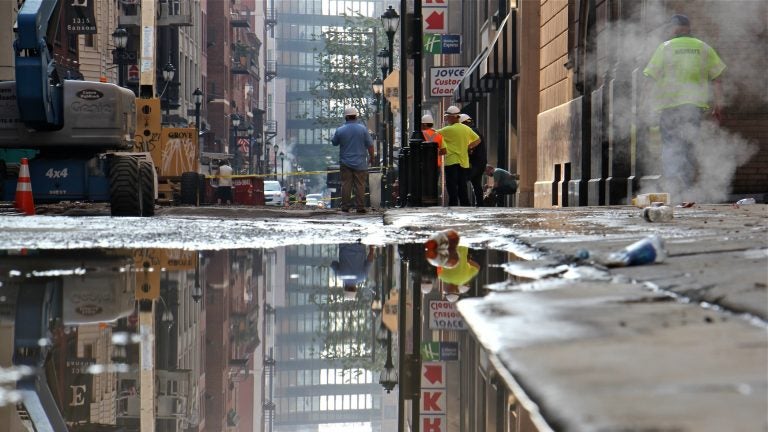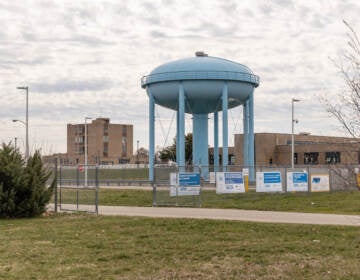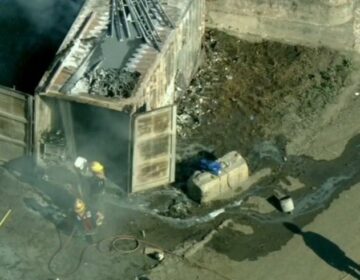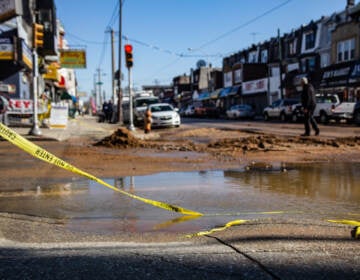Why does it take so long to upgrade Philly’s water infrastructure? Here’s an explanation
The July 3 rupture raised a lot of questions for Philadelphians. Chief among them: Is the city’s water infrastructure too old or too shoddy to prevent such events?

Steam pours from vents on Sansom Street near the site of a water main break that flooded Center City streets. (Emma Lee/WHYY)
When a broken water main sent 15 million gallons surging into Center City streets, public attention was riveted by scenes of pedestrians sloshing along and a cave-in that threatened to swallow the intersection of Juniper and Sansom.
The July 3 rupture raised a lot of questions for Philadelphians. Chief among them: Is the city’s water infrastructure too old or too shoddy to prevent such events? Is the Water Department, like seemingly everything else, underfunded?
According to current and former water commissioners, Philadelphia does not have a water infrastructure crisis, despite those apocalyptic images.
“We’ve had a number of breaks of this magnitude in the past decade,” said Howard Neukrug, who was water commissioner under Mayor Michael Nutter and is now a professor at the University of Pennsylvania. “And it will happen again. This is common throughout the Northeast and Midwest, which has a lot of infrastructure very similar to what we have in Philadelphia.”
Though the magnitude of this incident was unusual, leaking water mains are an almost everyday fact of life in Philadelphia, those familiar with the system said. There are 3,200 miles of pipes beneath the city, and the current five-year average is 267 breaks per every 1,000 miles.
What causes these breaks varies. There are 2,800 miles of small distribution mains that convey water throughout the neighborhoods; these range in size from 6 to 12 inches in diameter. These quotidian pipes are most vulnerable to winter cold, which can have a devastating effect on water infrastructure. (Water expands when it freezes, and that’s hugely disruptive.) The winter months are when Philadelphia sees as many as 80 percent of its breaks.
The system’s 400 miles of large transmission mains range from 16 to 93 inches in diameter. These tend not to suffer as badly from the wintertime blues. Nonetheless, there is a handful of such breaks every year and, like the most recent rupture, the reason isn’t easy to generalize.
Despite how often the term “aging infrastructure” is heard, years alone do not explain the July 3 break or others Philadelphia experiences. The 48-inch water main that broke in Center City was almost a century old, but Water Commissioner Debra McCarty told reporters that the break wasn’t necessarily related to the fact that the pipe was installed when Calvin Coolidge was president.
“It was installed in 1927, it’s a cast-iron main,” McCarty said the day of the flood. “Age is not bad.”
Vast stretches of Philadelphia’s water infrastructure are at least as old, if not older, than the main that broke July 3. Neukrug said that pipe laid in the 1880s and 1890s is “extremely durable” and still works fine. There are more likely to be problems with the pipes installed in the 1950s when joints were made of less reliable materials, he said.
A complicated scoring system helps the Water Department assess which stretches of pipe should be replaced or upgraded every year. Age is only one variable. The number of recent leaks or breaks is factored in, as are the consequences of a given stretch of pipe failing — and the presence of the weak joint material installed in the 1950s. The higher a stretch of pipe scores, the more likely the Water Department will target it for upgrades, which only a tiny percentage of its holdings receive each year.
Neukrug said Philadelphia leads the country in terms of determining which sections of pipe to replace.
“The problem in Philadelphia and other cities is the amount of pipe we need to replace,” he said. “If you replace it as a rate of 1 percent a year, of 3,200 miles of pipe, that’s 32 miles a year. Over the course of 100 years, you would have replaced all your pipes. Unfortunately, pipes from the 1960s through today have been replaced at much lower levels, maybe as low as half a percent, which means you are replacing the system on a 200-year basis.”
It costs $1.75 million per mile to replace the smaller distribution lines, while the cost leaps to $4.25 million per mile to replace the larger transmission lines. The 48-inch monster that broke at Sansom and Juniper would cost $6 million per mile to replace.
All told, a complete replacement of the water system would require $7 billion. But the Water Department is entirely funded by local ratepayers, which makes it impossible to come up with even a substantial fraction of that money all at once.
Instead, over the last 23 years, the Water Department has managed to replace 438 miles of water mains at an average of 19 miles per year. In the last three years, that’s accelerated to 27 miles per year.
Beginning in fiscal year 2019, the department projects being able to start replacing more than 1 percent of its lines a year.
Commissioner McCarty said the current replacement rate isn’t a huge problem. Instead, she noted that the campaign of targeted replacement has been a success: In the 1980s, Philadelphia experienced 350 breaks a year for every 1,000 miles of pipe. Now, she said, after years of targeting the most problematic sections, the city is down to 267 breaks per 1,000 miles.
“We don’t see this as a crisis,” said McCarty. The department, she noted, has shown the success of “thoughtful, judicious water-main replacements targeted to where the most need is — not just because it’s been 100 years or because someone has political pull. Because we have been doing this for years, we aren’t faced with a system that’s going to fall apart.”
Local drinking-water agencies all over the Northeast and Midwest United States are in a similar position, or worse. For many smaller municipalities, there really is an acute crisis.
At the University of Pennsylvania, Neukrug now advises other municipalities on best practices and looking at the bigger picture he said that federal aid is necessary.
“No, there never has been [federal aid for drinking water infrastructure], and it is massively needed,” said Neukrug. “At some point, the federal government must recognize that this is a national problem that requires a national solution.”
President Donald Trump has spoken often of investing in the nation’s aging infrastructure, but so far, that commitment has been only rhetorical. Which means the slow pace of replacement will continue, punctuated by periodic moments of frenetic activity when something breaks.
WHYY is your source for fact-based, in-depth journalism and information. As a nonprofit organization, we rely on financial support from readers like you. Please give today.







